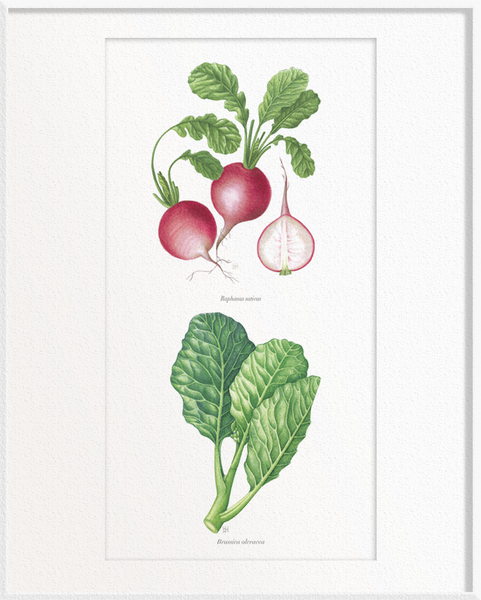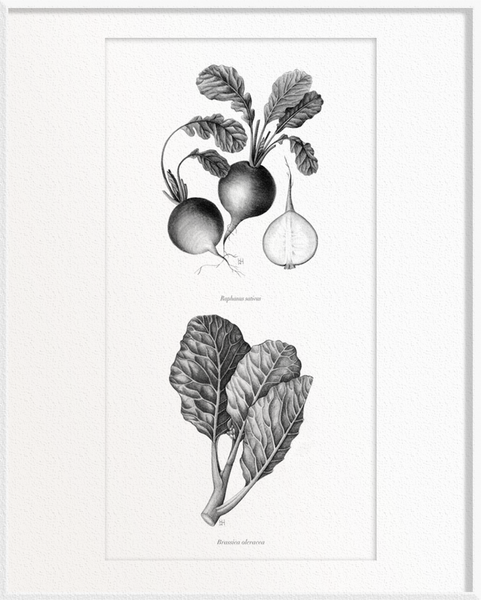Raphanus sativus (Radish) x Brassica oleracea (Kailan)
Raphanus sativus, commonly known as radish, is an edible root vegetable in the family Brassicaceae, domesticated in Asia before Roman times. It is believed that the origin of Raphanus sativus may be in Southeast Asia as it is the only region where wild forms have been discovered. Different forms seem to have developed in India and central China as well as Central Asia. Radishes entered historical records in the 3rd century BC. Raphanus sativus are annual or biennial crops grown for their swollen tap roots, which come in varying shapes. The root skin ranges from white to pink, red, purple, yellow and green to black, but the flesh is usually white with a pungent, peppery flavour. Although the root is eaten raw as a crunchy salad, the entire plant is edible. Raphanus sativus has a moderate amount of vitamin C. The seeds produce radish seed oil, a potential biofuel. Raphanus sativus has shown to have antidiabetic effects and is used in traditional medicine to treat many diseases such as jaundice, gallstone, liver diseases, indigestion and other gastric pains.
Brassica oleracea, commonly known in Southeast Asia as kailan or gai lan, is a plant species in the family Brassicaceae, which includes many common foods as cultivars such as cabbage, cauliflower and collard greens. This family of flowering plants are commonly known as the mustards, the crucifers or the cabbage family. Brassica oleracea is an important and established food crop, because of its large food reserves, stored over winter in its leaves. It is rich in essential nutrients including vitamin C. A leafy blue-green vegetable, it grows to about 30 centimetres tall when harvested. Believed to have been cultivated for thousands of years, its history as a domesticated plant is not clear before Greek and Roman times, when it was a well-established garden vegetable. It is a key vegetable in Asia cuisine and usually cooked as a stir fry. Brassica oleracea is an important source of dietary fibre, vitamins C and E, a range of B vitamins and carotenes.
°°°°°
Specifications:
Paper
100% Cotton based, 320g, Acid-free, No optical brighteners.
Printed Area
A3, 297mm x 420mm – Approximately 207mm x 342mm
About the Collection
The Garden of Miss Joaquim Collection: Illustrated Botanical Prints
Agnes Joaquim was a Singapore-born Armenian who created what would become Singapore’s National Flower, the Vanda Miss Joaquim (scientific name: Papilionanthe Miss Joaquim), in 1893. The artificial hybrid was recognised by the first director of the Singapore Botanic Gardens, botanist Henry Ridley.
Agnes, the first woman in the world to create a hybrid orchid, was a well-known and successful horticulturist, garnering 70 horticultural awards from 1881 to 1899. The Garden of Miss Joaquim Collection of botanical prints commemorates her horticultural legacy and complements her story told in the book Agnes and Her Amazing Orchid.
In presenting Agnes’s award-winning plants in the illustrated collection, we looked at the newspaper records of the times, but they were of no use because they used common name descriptions of the plants, such as ‘rose’ and ‘durian’. So we turned to the Singapore Botanic Gardens and collaborated with a botanist to identify the likely species. To complete Agnes’s story, the collection includes two additional images: of Vanda Miss Joaquim’s parents, Papilionanthe teres (pod parent) and Papilionanthe hookeriana (pollen parent) — formerly in the genus Vanda — both of which may have been present in her award-winning floral bouquets or cut flowers. Waiwai Hove, a talented and respected botanical illustrator, was chosen to produce the prints.
*Disclaimer: Representative only based on subject. Not species definitive.
About the Illustrator
Born in Kuala Lumpur, Malaysia, Waiwai Hove developed a love for nature from a young age. Growing up surrounded by rich tropical flora and nurtured by her mother, a keen gardener, Waiwai has always held a special place for plants in her childhood memories. She holds a diploma in botanical illustration from the Society of Botanical Artists (UK), graduating in 2013 with a distinction and the highest marks in the history of the course.
She has since worked for the Singapore Botanic Gardens, where highlights include illustrations for ‘30 Heritage Trees’ and more recently ‘15 Gingers’. Four of Waiwai’s ginger paintings were subsequently used for a series of stamps issued by Singapore Post in 2018. Since 2019, Waiwai has begun working on the cover illustrations of 14 volumes of The Flora of Singapore, to be published over the next few years. Her works are in numerous private collections and can also be found in publications by the National Parks Board and in the Shirley Sherwood Collection in Kew Gardens, UK.




